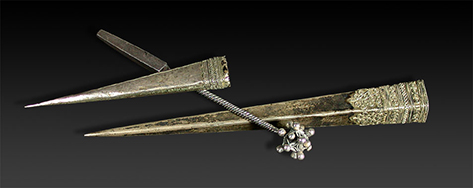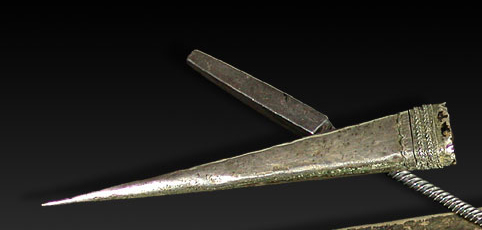In quotes are comments from Ethnic Jewellery and Adornment by Truus Daalder. Reference numbers are in italics and specified at the bottom. The photographs and other writing come from the collection and scholarship of The Creative Museum. I thought it would be interesting to combine them. They crossed paths in China, Indonesia, and Southeast Asia.
कंघी
“It is in the hairstyles and head decorations that perhaps the greatest variety of shapes exist, and the Southern Chinese minorities are possibly second only to the Mongolians in the exuberance of their headwear, particularly during festivals. Girls preserve hair lost in combing to compose extra hairpieces to incorporate into elaborate coiffures.” (1)
The dots and circles on the bone tines of this comb from The Creative Museum were made using pyrography, a technique where decorations are burned into wood or bone using a heated object. It also has cotton threads, black and white glass beads and a huge red pom pom in the middle. Red is the color of good fortune in China. The comb belongs to the Yao people.


“In pre-historic times, most of present-day Indonesia was attached to mainland Southeast Asia… However, when the ice melted after the last Ice Age, about 10,000 years ago, low-lying land was covered by sea, and Indonesia turned into a country of thousands of islands… Over time, waves of migrants came to the Indonesian islands, particularly from mainland Southeast Asia.” (2)
The dugout-canoe shape of this striking, lacquered black-horn comb from the Creative Museum evokes the boat that brought ancestors from the south-east Asiatic continent to the Indonesian archipelago. It was made c. 1970.

“The mainland of Southeast Asia is the meeting place of many borders and many ethnic groups. Burma, Thailand, Laos, and Vietnam share many of their borders with each other, and often share ethnic groups, as well.” (3)
Among the reasons for this are
- During the Ming Dynasty, the Han Chinese pushed minority groups south, and many settled in Southeast Asia
- Barbarian invasions from the North and Northwest pushed some Tai language speakers to Burma, Laos, and Thailand
- In the 19th century, kingdoms, such as the Khmer in Cambodia, gained and lost power, and there was British and French colonial expansion. Both factors changed the borders within Southeast Asia
- In 1949, minority groups who fought Communism fled China when Mao won, and fled Laos in 1975, when the Communists took over there
- Borders were of little concern to ethnic groups who practiced slash-and-burn agriculture (4)
The pyramid-shaped hair pins from The Creative Museum are worn by Red Taï and Hmong women in Laos. Their hairstyles often took more than one pin to keep them in place.

Made in the early 20th Century, the long one has a pyramid shape and ornate filigree decorations. It is hollow with a lid and used as a tobacco container, a marriage between beauty and function. The shorter one is wood wrapped in silver.


“The last dynasty before a period of instability and finally the victory of Communism in 1949 was the Manchu Qing Dynasty, consisting of Manchurian invaders from the North, which ruled from 1644 – 1911… Coral, jade, and pearls were popular, and during the Qing Dynasty there was also a revival of kingfisher feather jewellery. This was so popular that the kingfisher bird with the brightest blue feathers was hunted to extinction” (5)
Showcasing this history, the last piece I will feature is The Creative Museum’s stunning Manchu hairpin. It has three dimensions. The first layer is made of branch coral, amber, jadeite, and kingfisher feathers. The second layer is a circle of small coral beads, strung in small heart shapes. The third has a kingfisher decoration at the center. The piece is shaped to form a flower and bring good luck to the wearer.

कंघी
For more scholarly research, please see the exhibits and publications of The Creative Museum. To order a copy of Chinese and Japanese Hair Ornaments, please write to contact@creative-museum.com. Payment can be made through Paypal.
Also, every collector must have
 Ethnic Jewellery and Adornment |
References:
(1) Ethnic Jewellery and Adornment, by Truus Daalder, page 216
(2) Ethnic Jewellery and Adornment, by Truus Daalder, page 171
(3) Ethnic Jewellery and Adornment, by Truus Daalder, page 209
(4) Ethnic Jewellery and Adornment, by Truus Daalder, page 209
(5) Ethnic Jewellery and Adornment, by Truus Daalder, page 218
